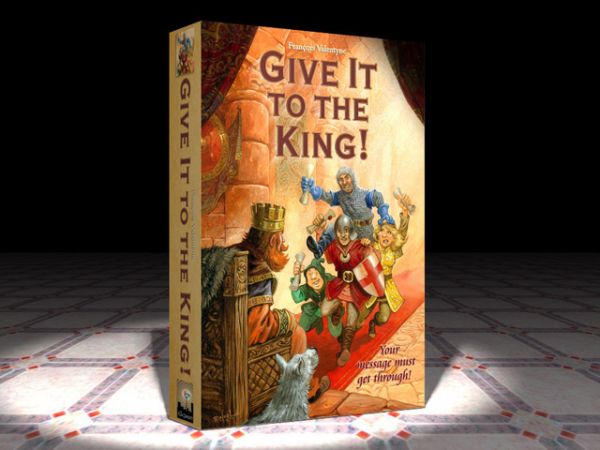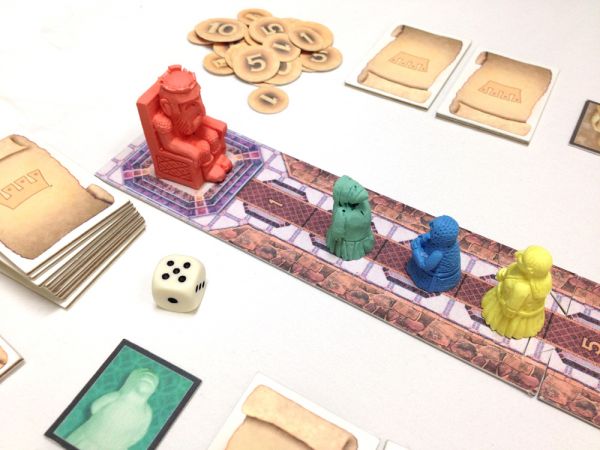Give It to the King: A Kickstarter Preview

Take a journey with me back to a time when messages were delivered not by text or email, or even snail mail as we know it, but as a handwritten and hand-delivered parchment. The king lazily sits on his throne as his servants receive messages of various importance, who then rush to get the message to the king as quickly as possible to be rewarded for their work.
Give It to the King! by upstart game publisher The Flux Capacity is a frantic and humorous casual game that captures the essence of medieval message delivery. We were recently given the opportunity to evaluate a prototype of the game, which is currently seeking your support on Kickstarter. We put it to the test and were very pleased with the outcome!
Game Play
In Give It to the King!, 2 to 4 players race down a long corridor trying to be the first to deliver their messages to the king. By doing so, they are rewarded handsomely with a certain amount of the king's gold, depending on the importance of the message. After 5 days (rounds) of play, the player who earns the most gold wins.
Movement – On a turn, the player rolls a single 6-sided die and moves any messenger toward the king the exact number of spaces rolled. But why not just move your own messenger each time? To be a valid movement, a messenger must jump over one or more of the other messengers to land on an empty space, thus your own messenger may not be able to move. In addition, a player can continue rolling and moving messengers on his turn for as long as he wishes until either he moves his own messenger, a messenger reaches the throne, or no movement is possible. If a 1 is rolled, the player furthest from the king must be moved to the front of the line.
Revealing a Message – Players start out the game with 2 messages placed face down on the table, with a new one drawn at the beginning of each round. Messages have two possible uses: one is to gain gold when reaching the king, and the other is an action that can be used to affect the current turn. Actions include adding numbers to the die roll, re-rolling the die, stopping the turn, and continuing the turn when it would have ended. They are used by revealing the message card after the die is rolled on anyone's turn. Only 1 action can be used after each die roll, so only the first player to reveal a message can use it. These actions must be used with discretion, however, as doing so prevents that message from being delivered to the king for gold. At the end of the round, revealed message cards can be returned face down at the cost of 1 gold per card.
Blaming the Captain – The player with the most gold is designated as the Captain of the Messengers. When the die is rolled and no movement is possible, the Captain is blamed for this delay and must pay 1 gold coin to the king. If another player has more gold than the current Captain, he is designated as the new Captain.
Review
Our groups had a blast with Give It to the King! It is fun and fast-paced, yet it is also full of interesting decisions and balancing mechanisms to keep the game close and overcome the randomness of the die rolls. Elitist gamers might be inclined to scoff at the roll-and-move mechanic, but we found it to be enjoyable and effective in this game, since the player must decide which messenger to move and whether or not to affect the roll by revealing a message card at the expense of its face value. Since a message can be revealed on any player's turn, there is no downtime — players must remain vigilant and ready to reveal a message as quickly as possible, if it becomes advantageous to do so.
Balancing mechanisms include the incentives to move other players, the Captain's payment of gold when movement is not possible, and a gold coin given at the beginning of each round to the player who is furthest from the king. In addition, a player who reaches the king and cashes in his messages for gold will have fewer messages available in subsequent rounds, while the other players retain their messages — giving them more potential for gold and more options for actions to use.
While there are several minor rules to keep track of, the game is easy enough to teach in under 10 minutes and the play time is about 30 minutes. It is designed mainly for 4 players, yet the variant for 2 or 3 players also seems to work well (albeit with some added complexity due to extra rules). In terms of quality, if the prototype we received is any indication of the final product, there is nothing to worry about. The prototype is solidly built, with resin figurines and a sturdy board and cards (note: the resin figurines are available as a stretch goal, and the prototype figurines have some imperfections that I trust will not be in the production version). The rules are also well-written and polished, with no noticeable errors or problems.
Give It to the King! is a game that I would highly recommend as a great choice for casual gamers. If you're interested in supporting the production of this game, you can reserve a copy on Kickstarter until September 20, 2013.
Pros: Interesting decisions, fun theme, well-balanced luck and strategy, no downtime
Cons: Optimized for 4 players (extra rules required for 2 or 3 players)
Disclaimer: this preview is based on our evaluation of an unpublished prototype of the game, which is subject to change prior to publication. While a modest payment was received to expedite the review process, our thoughts and opinions expressed here are honest and accurate.





